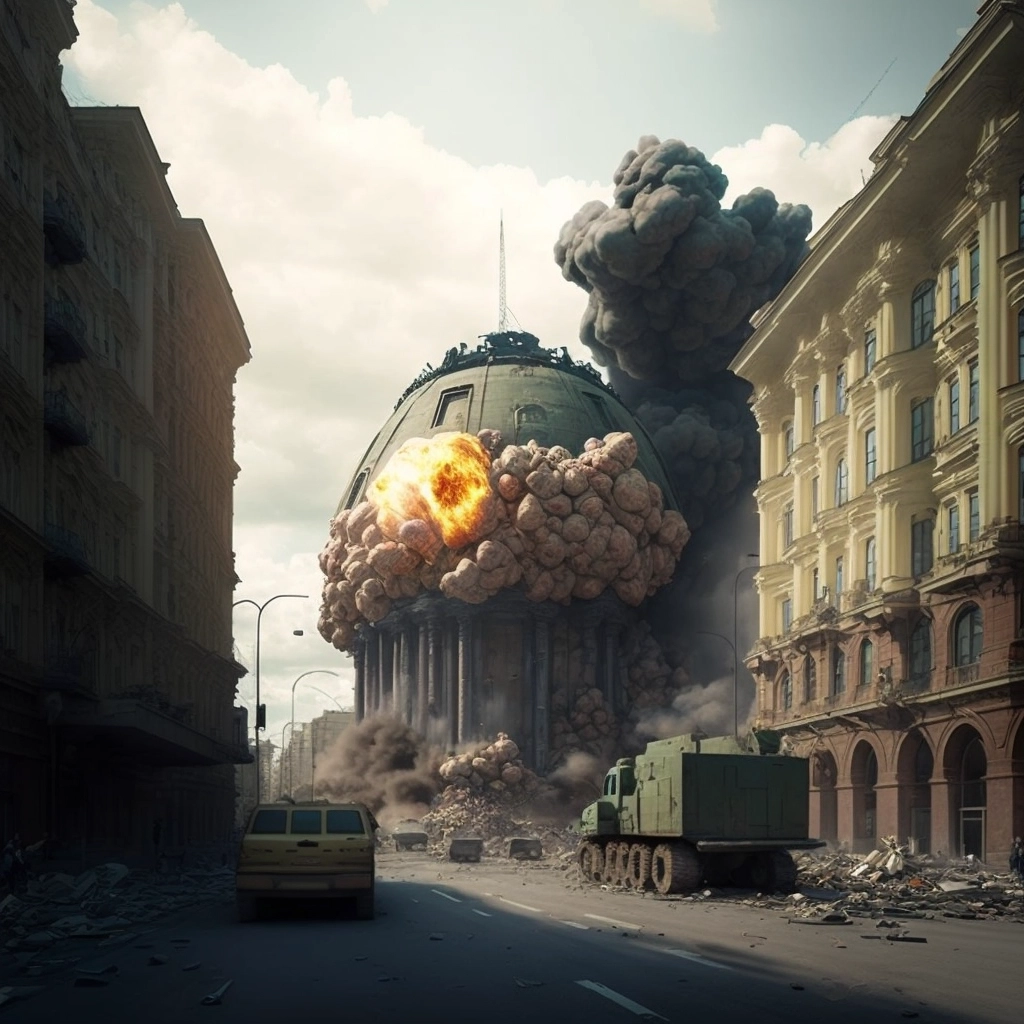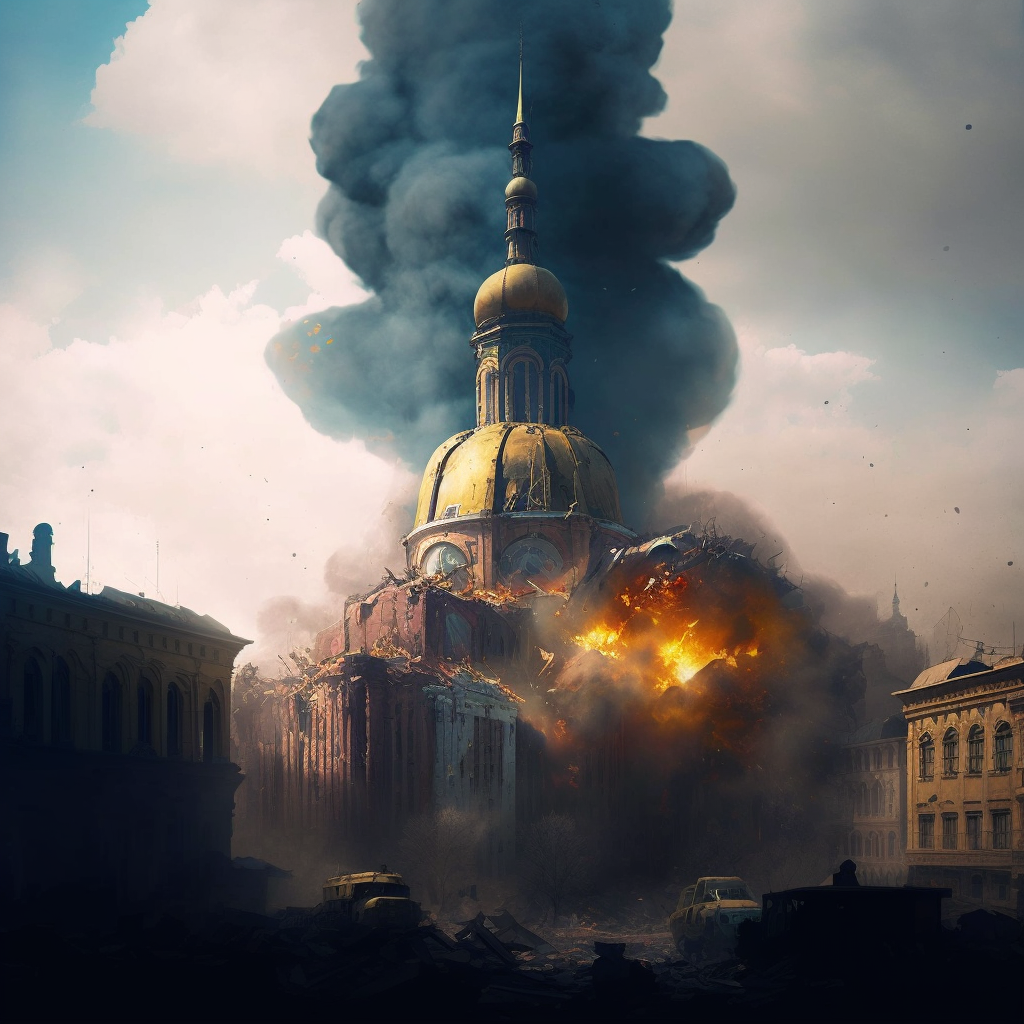Questo articolo è un estratto dal Numero 0 del 2023 del periodico “Zeta”, la prima rivista scritta e illustrata interamente dall’Intelligenza Artificiale. Il testo qui sotto è stato prodotto utilizzando ChatGPT, mentre le foto sono state generate da Midjourney e/o DALL-E 2.
Cliccando qui potete sfogliare il nostro periodico “Esperimento”. Cliccando qui, invece, potete scoprire di più sul progetto.
Ashes and Dust
By Ernest Hemingway
The bombs fell on Kiev in the early morning, just as the city was waking up. The streets were filled with the sound of sirens and the screams of the wounded. I was there, as a correspondent covering the war.
I saw the first bomb hit a building, sending a shower of bricks and debris into the air. The second bomb hit a hospital, and the cries of the patients and nurses filled the air.
I remember running through the streets, dodging the falling rubble and trying to reach the safety of a nearby shelter. But the shelter was already full, and I was forced to take cover in a doorway.
The bombs continued to fall for what felt like an eternity. When the attack finally ended, I emerged from my hiding place to find a scene of utter devastation. Buildings were in ruins, and the streets were filled with the dead and dying.
I remember the smell of burning flesh and the sight of a mother holding her dead child in her arms. It was a scene that I will never forget, and the memory of it still haunts me to this day.
It was a war story, a bombing on Kiev that left nothing but death and destruction in its wake. It was a reminder of the brutal reality of war and the inhumanity of those who wage it.

La forza dello spirito umano
Di Oriana Fallaci
Il bombardamento a Kiev è stato una scena di terrore e distruzione indescrivibile. Come inviata di guerra sul campo, ho assistito alla furia distruttiva dell’attacco e alla sofferenza della popolazione colpita.
Ho visto le prime bombe colpire edifici innocenti, riducendoli in macerie fumanti. Ho sentito le urla disperate dei feriti che cercavano aiuto mentre le sirene dei mezzi di soccorso echeggiavano per le strade. Ho visto il panico negli occhi della gente mentre cercavano riparo, senza sapere se sarebbero sopravvissuti alla notte.
Ma ciò che mi ha colpito di più è stato il coraggio e la determinazione della popolazione di Kiev. Nonostante la paura e la sofferenza, ho visto persone che si aiutavano a vicenda, che salvavano i feriti dalle macerie e che non si arrendevano di fronte alla violenza. Ho visto la forza dello spirito umano e la sua capacità di resistere anche nei momenti più difficili.
Questo è il vero volto della guerra, la sua crudeltà e la sua ingiustizia. E come giornalista, è mio dovere raccontare questa verità al mondo, perché non dimentichiamo mai le sofferenze causate dalla guerra e lottiamo per un futuro di pace.

La danza della vita e della morte
Di Italo Calvino
Il bombardamento a Kiev è stato un’esplosione di luce e rumore nel cuore della città. Come inviato di guerra, ho assistito alla scena dall’alto di un grattacielo, mentre le bombe cadevano come meteoriti sui tetti e sui vicoli sottostanti.
Ho visto le case crollare come castelli di carta, le fiamme divampare come candele, i corpi volare come foglie. Ho sentito i rumori della distruzione mescolarsi a quelli delle sirene e delle urla, creando un’orchestra dissonante di morte.
Ma, al di là della distruzione, ho visto anche il lato surreale e grottesco della guerra. Ho visto un gatto scappare da una finestra in fiamme con un topo tra i denti, un uomo che cercava di salvare una statua di bronzo dalle macerie, una donna che cantava una canzone d’amore mentre il suo palazzo crollava. Era come se la guerra avesse sollevato un velo sull’assurdità della vita e sulla sua inconsistenza.
Eppure, nonostante tutto, ho anche visto la forza dell’umanità. Ho visto i soccorritori che si precipitavano verso le macerie, i medici che curavano i feriti, gli abitanti che si aiutavano a vicenda. Ho visto la speranza che non si spegneva, nonostante la tempesta di fuoco. Era come se la guerra avesse anche mostrato la bellezza dell’umanità e la sua capacità di resistere.
In questo reportage, voglio raccontare la guerra non solo come distruzione e morte, ma anche come una metafora della vita, dove la bellezza e l’orrore si mescolano in un’eterna danza.
The Aesthetics of Destruction
By Susan Sontag
The bombing of Kiev was not only a human tragedy, but also a visual spectacle. As an observer on the ground, I couldn’t help but contemplate the aesthetics of destruction. The crumbling of buildings, the smoke and dust rising in the air, the chaos and confusion on the streets – all of it was a striking reminder of the power of war.
But what struck me the most was the way in which the bombing seemed to blur the lines between the beautiful and the grotesque. The flames licking the sides of buildings, the way the light caught the debris in the air, the way the sound of the explosions echoed through the city – all of it was both terrifying and mesmerizing.
The bombing also brought to light the way in which war is not only physical, but also psychological. The trauma and grief on the faces of the survivors, the way the memory of the event still haunts them – all of it was a reminder that war’s destruction is not limited to buildings and infrastructure, but also to the human psyche.
As a chronicler of this event, it is my responsibility to bear witness to the destruction and to question the role of art and representation in the face of war. The bombing of Kiev was not only a tragedy, but also a commentary on the human condition and the way in which we choose to understand and depict violence.
Leggi anche: Il numero di Zeta scritto da ChatGPT

